NVIDIA Shield Review: At the Crossroads of PC and Mobile Gaming
by Brian Klug on July 31, 2013 12:14 AM ESTGFXBench 2.7.0
While GFXBench 2.7 (formerly GLBenchmark 2.7) doesn't yet take advantage of OpenGL ES 3.0 (GLB 3.0 will deliver that), it does significantly update the tests to recalibrate performance given the advances in modern hardware. Version 2.7 ditches classic, keeps Egypt HD and adds a new test, T-Rex HD, featuring a dinosaur in pursuit of a girl on a dirt bike.
Scene complexity goes up tremendously with the T-Rex HD benchmark. GLBenchmark has historically been more computationally bound than limited by memory bandwidth. The transition to T-Rex HD as the new flagship test continues the trend. While we see scaling in average geometry complexity, depth complexity and average memory bandwidth requirements, it's really in the shader instruction count that we see the biggest increase in complexity.

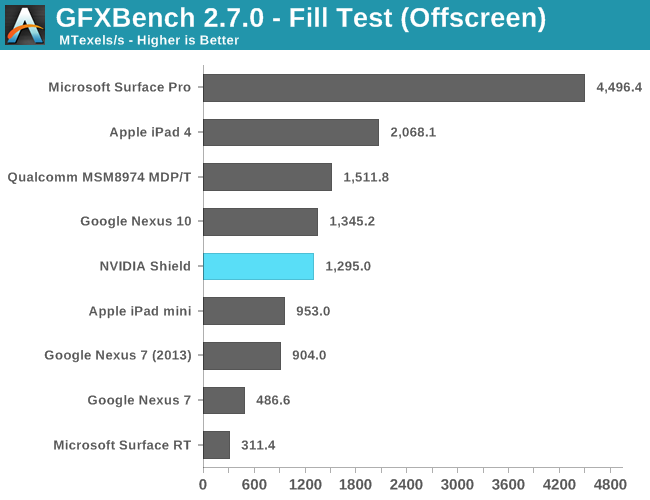
The fill rate tests put Shield significantly behind the iPad 4 and about on par with the Nexus 10. Looking at Triangle throughput we see Apple hold onto an advantage there as well, although Tegra 4 does show impressive gains over Tegra 3.
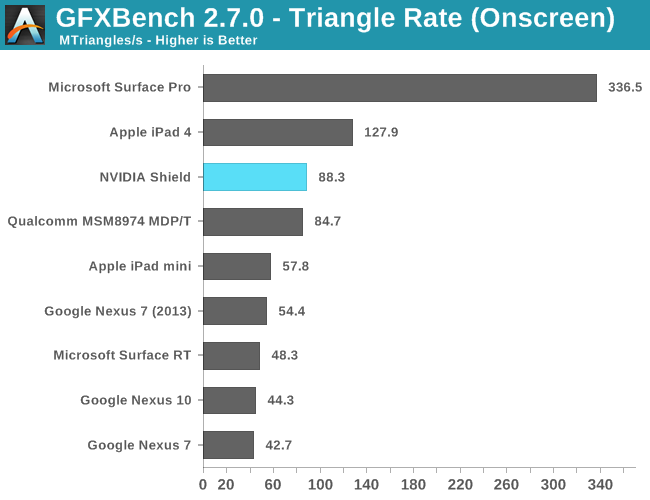
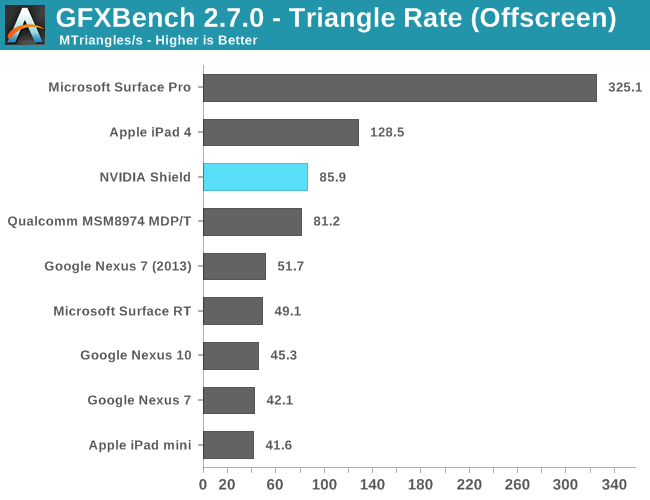
It's really in the pixel shader bound tests that Tegra 4 really excels:
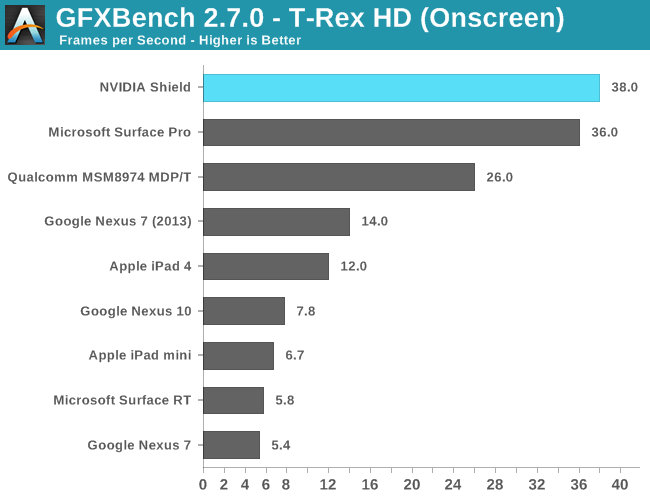
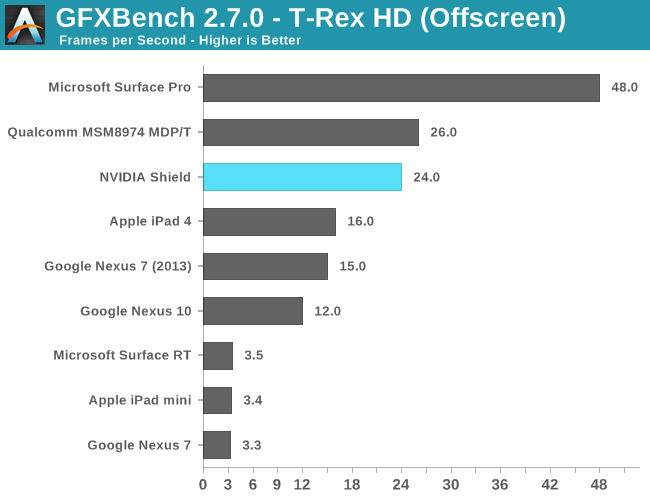
As promised, Tegra 4's GPU manages to outperform the iPad 4's PowerVR SGX 554MP4 in GFXBench 2.7. The 50% performance advantage is appreciable, and should be very nice on a high res display. It's a shame Shield is stuck with a 720p panel. Note that we're also half way to the performance of Intel's HD 4000 here. The Adreno 330 comparison is, once again, extremely close. Qualcomm pulls ahead by 8% and that's without a fan in a tablet chassis.
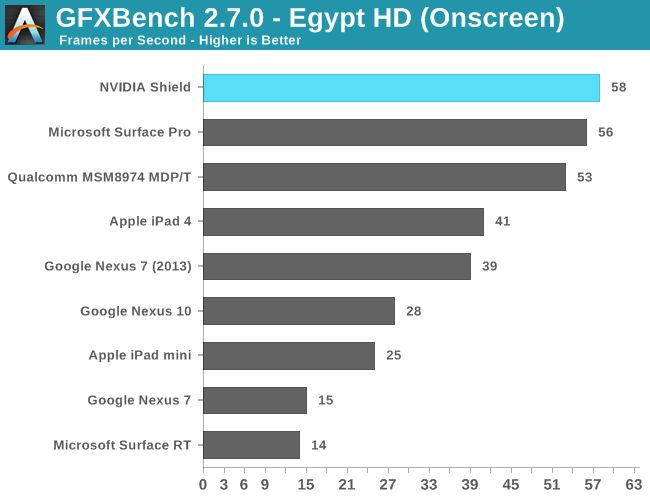
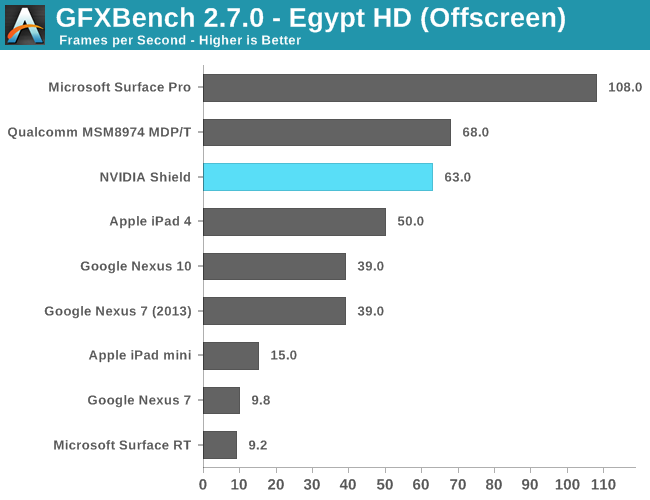










134 Comments
View All Comments
DesktopMan - Wednesday, July 31, 2013 - link
Do you really need 1080p in a gaming device at this size? I'd prefer not to gimp performance. I agree that it should have been larger though, since there is space for it.Cohaagen - Wednesday, July 31, 2013 - link
I agree. I'm even happy with the 960x544 resolution of the PS Vita, so I have no problem with the 1280x720 resolution for the same screen size.JNo - Wednesday, July 31, 2013 - link
I agree. I'm amazed Brian is still gunning for 1080p. I can't imagine it would stream well at all wirelessly, especially games where laglass performance is a deal breaker. Most people can't get 1080p movies to stream over wireless N without significant issues.And it would shove the cost up significantly on what is already a non-impulse purchase.
Sorry Brian, obviously 1080 would be beautiful but it has to work and make economic sense. I'm really surprised you don't/didn't see this. Not trying to sound rude because I really love your writing.
nathanddrews - Wednesday, July 31, 2013 - link
Getting 1080p 1:1 Blu-ray (48Mbps) to stream over N is difficult without excellent conditions, but something compressed down to a Netflix-sh 8-10Mbit stream with 5.1 audio is more than realistic, even over G. Double the rate to reduce artifacts and you're golden.Sertis - Wednesday, July 31, 2013 - link
Most PC games don't scale up their fonts and fine details for higher PPI screens. If you can't see the pixels at a comfortable playing distance, you probably can't read the 12 point text. 1080p on a 7" screen might work, but that's pushing it.damianrobertjones - Wednesday, July 31, 2013 - link
"5-inch 1280x720 "Retinal" Display"Retinal display? Is that a 'Retina display' but not quite?
A5 - Wednesday, July 31, 2013 - link
"Retina Display" is an Apple trademark, iirc.jjj - Wednesday, July 31, 2013 - link
Interesting review , i don't think it will sell ,the hardware seems nice but the concept is problematic.Maybe for this one you should have included some loading time tests, the NAND perf doesn't seem all that good and made me wonder how much it impacts loading times.
Hope you guys will have a T4 tablet review soon, the Toshibas and the HP are in retail.
R3MF - Wednesday, July 31, 2013 - link
"I said in the Nexus 7 review that I wished whatever happened to Tegra 4 that delayed it hadn't, so we could see it in more devices."I glad Tegra couldn't be included in the Nexus7 update, that would have meant no OpenGL ES 3.0 and no OpenCL.
Arbee - Wednesday, July 31, 2013 - link
This thing, far more than the CPU-gimped Ouya, is the ultimate emulation machine. It's one of the first ARM devices with enough CPU grunt to do some really impressive things in that space, and Nvidia isn't blind to that market; they've been seeding beta units to emulation programmers. There's a new version of MAME4Droid with explicit support for it out already, for instance.